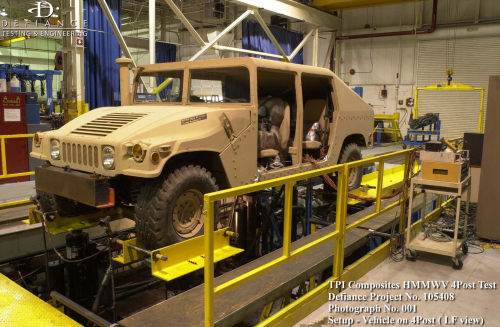
The military's High Mobility Multi-purpose Wheeled Vehicle (HMMWV) was selected as the platform for TPI's composite vehicle. The body structure of the ACMV, including the frame rails, were constructed of composite materials and contain no metal.
Standard HMMWV drive trains, suspensions and other accessories were fastened to the composite body with methods similar to those used for steel and aluminium HMMWVs.
TPI claims this composite prototype saves 900 lbs compared to traditional HMMWVs and provides a more durable alternative.
TPI Composites CEO Steve Lockard says the composite vehicle is a huge step forward in military vehicle engineering.
"We are very pleased with the performance of TPI's All Composite Military Vehicle," says TPI Composites CEO Steve Lockard. "A vehicle like this gives the US Army several significant options to improve its HMMWV fleet. Not only will this vehicle give our troops increased mobility, its lighter, high-strength composition will allow for significant fuel efficiency and potentially allow for the addition of enhanced armour or greater payload."
The ACMV prototype was tested on a vehicle test simulator by Defiance Testing & Engineering in Troy, Michigan, USA, in October and November 2009. The vehicle was sent to Chrysler's Chelsea Proving Grounds for 85 hours, representing a 50 000 mile road test. The data represented a severe off road schedule typically used for light trucks and sport utility vehicles. The composite vehicle was tested in two different configurations – ballasted and un-ballasted. Other project team members that supported the programme included the University of Delaware's Center for Composite Materials.
The ACMV was also tested at Nevada Automotive Test Center (NATC) between December 2008 and May 2009 and was subjected to static stability, dynamic stability, ride quality and peak acceleration tests.
The composite vehicle was also tested for 5000 miles on a mission profile-representative course. The road test consisted of 1500 miles of primary roads, 1500 miles of secondary roads and 2000 miles of cross-country travel.
TPI Composites reports that the ACMV performed very well at NATC and Defiance, exhibiting no significant structural failures.
"We're proud to apply our expertise in composite technology to assist the military in providing a lighter, safer, more durable vehicle for US troops," says Lockard. "From our beginnings as a custom yacht manufacturer to the wind turbine blades we supply to GE Energy and Mitsubishi Power Systems to our military products, TPI has a heritage of innovation in composite manufacturing."
The next and last significant phase of testing of the ACMV is blast testing. This is likely to take place in the first half of 2010.
TPI Composites is a Scottsdale, Arizona, USA, supplier of wind turbine blades. The company also works in the transportation and military vehicle markets. TPI has designed and built improved HMMWV Mine Resistant Ambush Protected (MRAP) hood, and prototyped the first All Composite Cab for the Heavy Expanded Mobility Tactical Truck (HEMTT) platform.
TPI Composites operates factories in the USA, Mexico and China.
